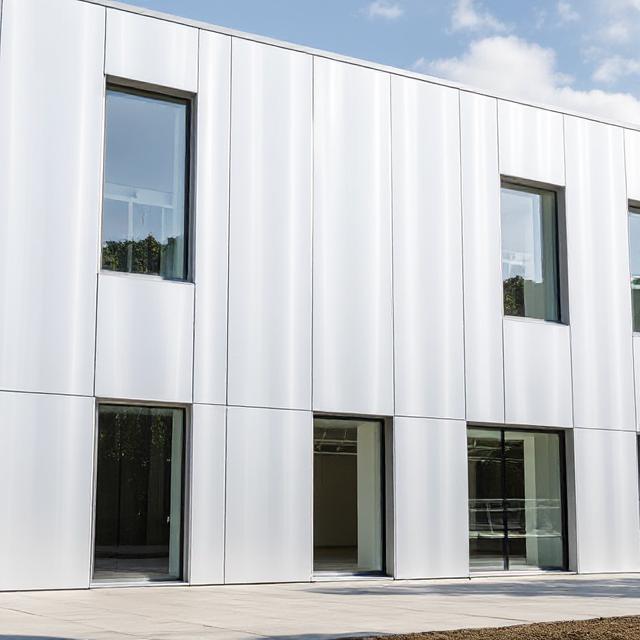


One material that has gained immense popularity in recent years and continues to dominate in 2025 is aluminium wall cladding.
In the evolving world of architecture and construction, the materials selected for a project have a significant impact on the building’s aesthetics, durability, cost, and environmental footprint. One material that has gained immense popularity in recent years and continues to dominate in 2025 is aluminium wall cladding. More architects and builders are opting for aluminium cladding panels due to their sleek look, outstanding performance, and versatility. Let’s explore the reasons behind this growing trend and understand why aluminium is becoming the material of choice for modern wall cladding systems.
Architectural designs in 2025 are all about clean lines, bold textures, and dynamic finishes. They offer unmatched aesthetic versatility. They are available in a wide range of colours, patterns, and textures, including wood grain, metallic, matte, and glossy finishes. This gives architects the creative freedom to design unique and eye-catching facades that stand out while complementing the urban landscape.
Similarly, aluminium cladding sheet products can be cut and moulded into various shapes and forms, allowing for innovative design solutions. Whether it’s a commercial high-rise, a residential complex, or a public infrastructure project, aluminium cladding can be tailored to match the architectural vision seamlessly.
One of the primary reasons behind the increasing preference for aluminium cladding panels is their exceptional durability. Unlike traditional materials that may degrade or corrode over time, aluminium is highly resistant to weathering, UV rays, moisture, and pollution. This makes it ideal for buildings located in coastal or industrial areas where harsh environmental conditions are common.
Time and efficiency are crucial in construction projects, and these panels provide a distinct advantage in this regard. Being lightweight compared to materials like steel or concrete, aluminium reduces the overall structural load of a building. This allows for more flexibility in design and simplifies the installation process.
Moreover, aluminium cladding sheet systems are often prefabricated, ensuring precise dimensions and quick on-site assembly. This results in reduced labour costs, faster project completion, and fewer disruptions during installation. Builders appreciate this ease of use, which translates into significant time and cost savings.
Additionally, aluminium sheet products can improve a building’s energy efficiency by reflecting sunlight and reducing heat absorption. This thermal performance contributes to lower cooling costs, especially in hot climates, and helps buildings achieve green building certifications such as LEED or IGBC.
Safety standards in the construction industry are more stringent than ever, and aluminium meets many of these requirements with ease. Modern aluminium cladding panels are designed with fire-retardant cores or coatings that enhance their fire resistance. This added layer of protection is crucial, particularly in high-rise buildings and public spaces.
The aluminium cladding sheet acts as a barrier that helps contain fire and limits its spread, providing occupants with more time to evacuate safely. This compliance with fire safety regulations makes aluminium cladding a preferred choice among responsible architects and builders.
One of the most attractive features of these cladding panels is the minimal maintenance they require. Unlike wood, which may need regular painting or sealing, or concrete that can develop cracks over time, aluminium surfaces are easy to clean and maintain. They resist stains, mould, and corrosion, maintaining their appearance with just occasional washing.
When you consider the long-term benefits, aluminium cladding sheet systems offer a high return on investment. The initial cost may be slightly higher than some traditional materials, but the durability, low maintenance, and energy savings make aluminium cladding a cost-effective solution over the building’s lifecycle.
The climatic adaptability of aluminium cladding panels is another reason for their growing demand. These panels provide excellent protection against water ingress, ensuring the structural integrity of the building. Additionally, with the right insulation behind the cladding, aluminium systems can improve the acoustic performance of walls, reducing external noise – a critical feature in urban environments.
Similarly, aluminium cladding sheet applications can be tailored to incorporate thermal and soundproofing layers, providing comfort and energy savings to building occupants. As a result, aluminium cladding is not just an aesthetic feature but a functional enhancement to modern construction.
As construction trends in 2025 continue to emphasise sustainability, safety, speed, and style, it’s clear why aluminium wall cladding is gaining widespread popularity. The numerous benefits of aluminium cladding panels, from their sleek, modern appeal to their durability and eco-friendliness, make them a superior choice over traditional cladding materials.
